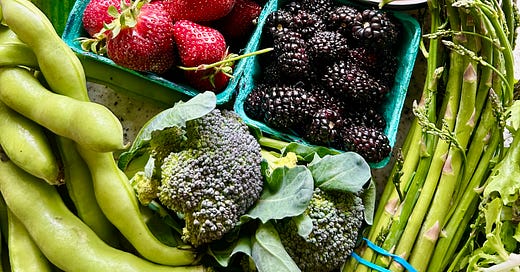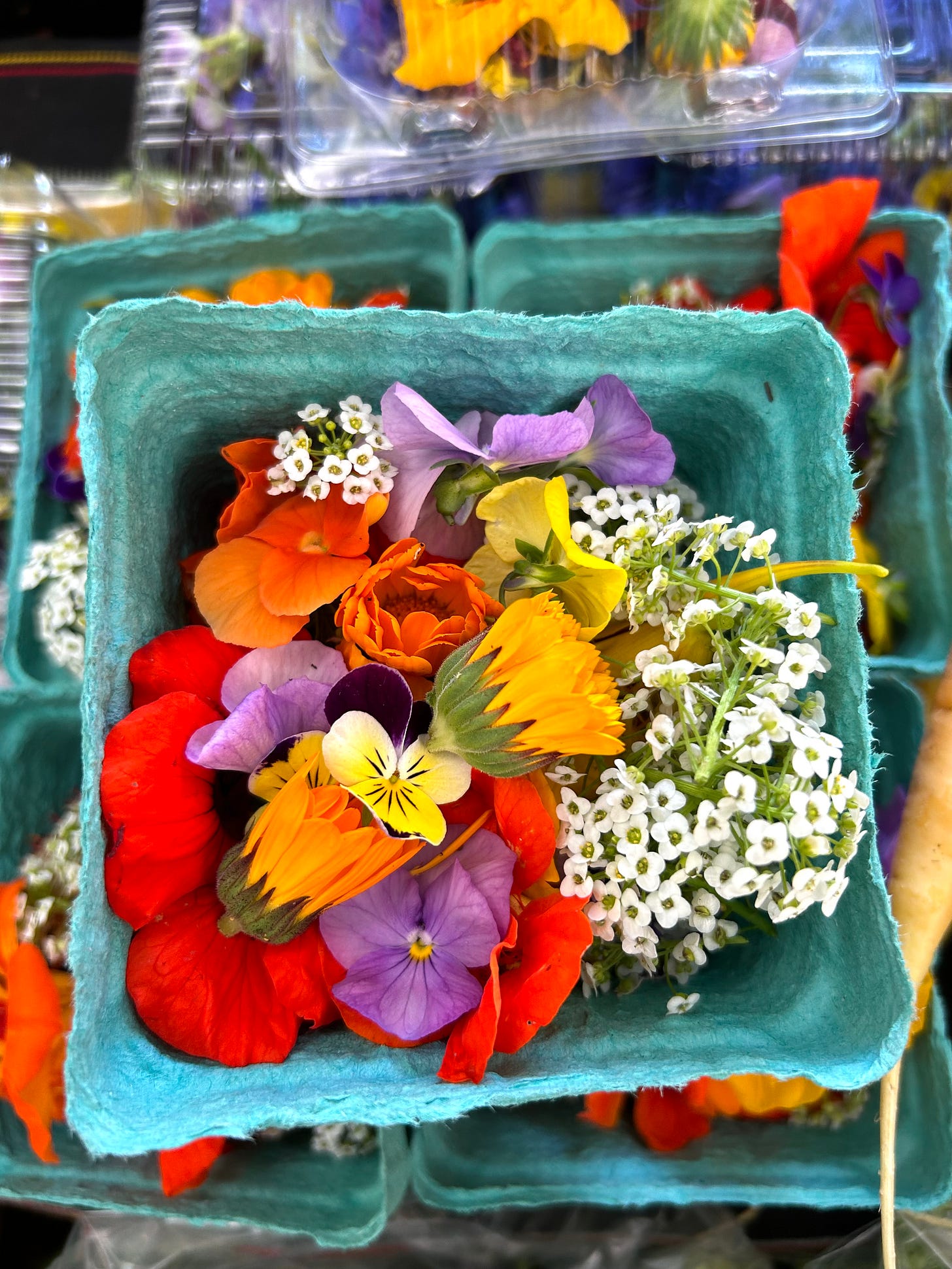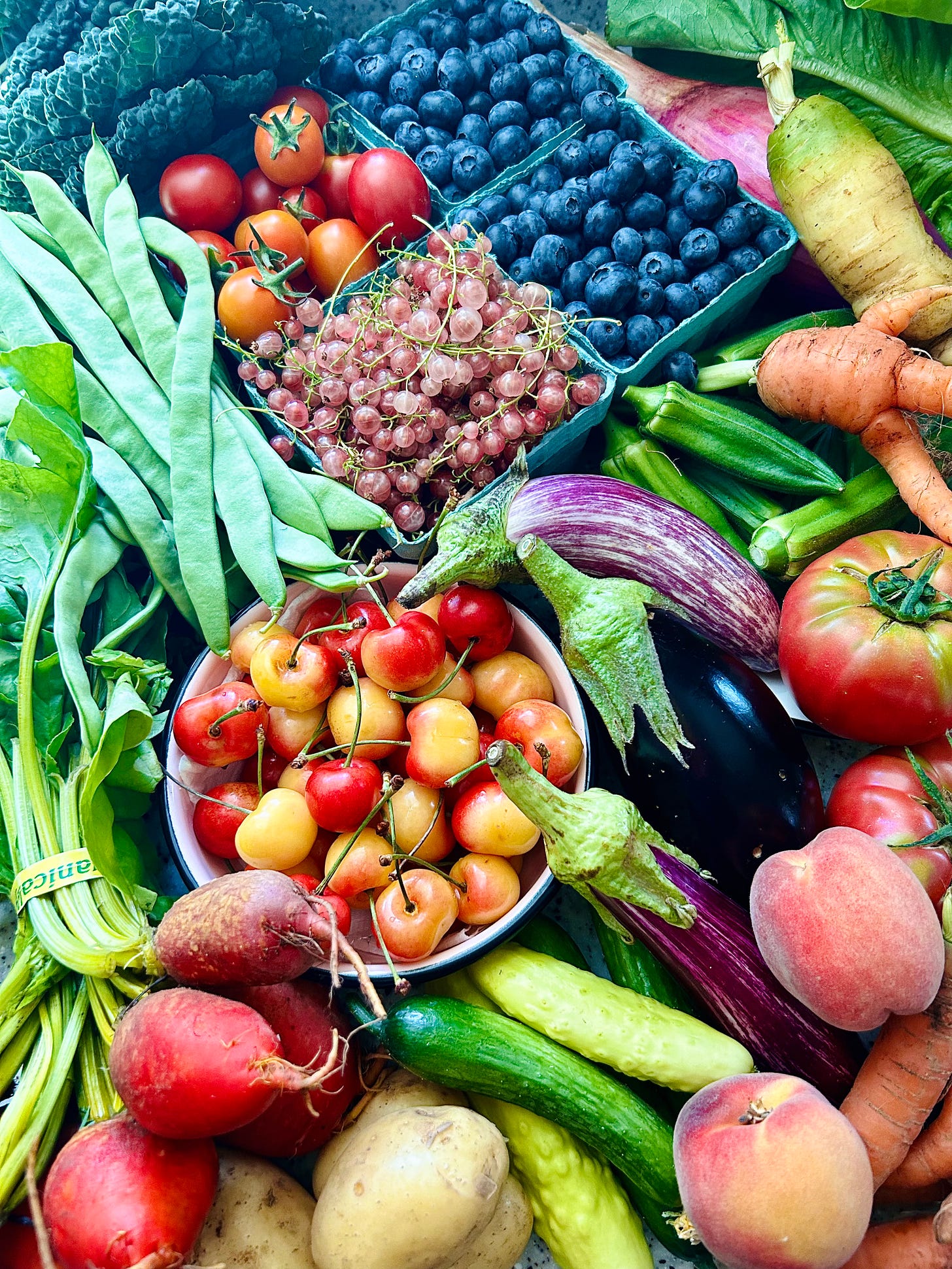Below, you’ll find my approach to the farmers’ market and a shopping list with links to seasonal recipes.
Did you know that Substack lets you comment on these posts? If you enjoy these newsletter installments, I’d love to hear from you.
Happy Shavuot to those who celebrate!
And happy cooking and eating,
Sonya
A friend recently texted and said they got a beautiful array of produce from the farmers’ market, but once they got home they were at a loss for what to do with it.
Could I help?
I started shopping at the Hollywood Farmers’ Market (HFM) in California in my twenties — my income was meager, but I still had a taste for life’s finer things. I was overwhelmed at first. Who had the best strawberries? Why did I get these peaches, when the ones over there looked so much better? What will I do with this pile of vegetables once I’m home?
I persevered. Weeks turned into months turned into years. With each passing Sunday, I began to learn exactly who had the best strawberries and when they had them. I discovered what will forever be referred to as the “life-changing lettuce.” I became friends with vendors and shoppers. Julie Delpy once aggressively cut me in line for stone fruit. Most importantly, I got to know the people growing my food.
A dream came true when the aforementioned life-changing-lettuce farmer invited me to visit his farm in Santa Ynez. (This is a longer story for another time). I thought about his sun-soaked plot of land every time I made a salad with their farm’s little gems.

The more I shopped at the HFM, the less I bought produce elsewhere. I soon found that eating with the seasons and connecting to the people who passionately produce food not only enriches my diet, but it changes the way I feel in my body.
And then I left California and its citrus, avocados, passion fruit, pomegranates, dates, and exemplary lettuce.
Before moving, we took a trip to Portland to find a place to live. That week we visited the Portland farmers’ market at Portland State University. Everywhere I looked, there was bounty: chive blossoms, purple asparagus, deep red rhubarb! Our new home welcomed us gloriously.
It’s been six years (this week) since I moved back to Portland. Weeks turned into months turned into years. I’ve learned who has the best strawberries and when they are the best (I now resist the urge to buy them in their first few weeks). I have become friends with farmers, vendors, and shoppers. I have visited my favorite farms and shared meals with the people that grow our food.
As evangelical as I am about farmers’ markets, if they’re not your thing, or don’t fit into your schedule, I get it. They’re not for everyone for a myriad of extremely valid reasons. Luckily, even if you are still looking for exceptional seasonal produce, many grocery stores now carry locally grown fruits and vegetables, or better yet, you may be growing your own.
But if you are curious about exploring the farmers’ market but haven’t yet made it a regular thing, I’ve included some of my FAQs and a shopping list below.
Frequently asked farmers’ market questions:
Is it more expensive?
Yes and no. When you’re buying items in their peak season, they’re often the same price or better as the grocery store, especially for organic produce.
Does the produce taste better?
A resounding, unequivocal yes. Food that has been stored and traveled inherently tastes different than just-picked, ripe produce. Is that difference subtle? Sometimes. Is it consistently noticeably better? Yes.
I really want to shop at the farmers’ market but I get overwhelmed and can’t figure out what to buy.
Trust your gut. Don’t get lured by long lines or beautifully arranged produce, instead pick out what looks best to you.
When you’re stumped, and if it feels easy/appropriate, ask for a sample — many farmers are willing to let you discover the value for yourself.
If you pick out something and are disappointed later, or if you think you made the “wrong” choice by going with one vendor intstead of another, there’s always next week!
What do I do with all this produce when I get home?
Below are links and ideas for seasonal recipes.
I also recommend talking to the farmer/vendor. If you see a new-to-you ingredient, ask: “What do you recommend using this for?” They almost always have simple ideas and often you’ll find that other buyers (and chefs) chime in with their favorite dishes to make.
Kari and I also dedicated a whole Food Friends episode on how to shop the farmers’ market, with lots of info on the best way to store all that produce!
As we’re entering into a season of abundant local produce in the Northern Hemisphere, here’s what I’ve been picking up and what I’m doing with it…
Farmers’ Market Shopping List
Asparagus
Blanched with sugar snap peas and tossed in a walnut basil pesto
And very eager to try Nora Singley’s Green Sesame Tonnato with Asparagus
Sugar snap peas
I love to include them on a snacky lunch plate, or served with a fun dip liked whipped feta drizzled with honey and chili oil.
Fava beans
So delicious in a pasta dish like this Cacio e Pepe pea and fava recipe. Full disclosure: they are a little fussy to make, but if you like meditative tasks like shelling beans, and then pealing them after they are boiled, favas are for you!
I also enjoy them as a topping for toast or as a topping for hummus. For a quick and easy homemade hummus, I’m partial to Michael Solomonov’s 5-minute hummus recipe that uses canned chickpeas.
New potatoes
For simple Japanese curry
Or for mashed potatoes with garlic and dill — Boil unpeeled potatoes until tender, then roughly and freely mash them, add a heap of dill, raw finely minced garlic, and a generous amount of olive oil.
Little gem lettuce
For salads with radish and cucumber, mint, in a lemony vinaigrette made with wholegrain Dijon and grated garlic.
Zucchini
Simple Hobok Jeon, a Korean dish of lightly breaded and shallow fried zucchini rounds
Zucchini with quinoa, basil and za’atar (recipe from Braids)
Cucumber
For a deli-style cucumber salad with dill and onion (recipe from Braids)
Chioggia Beets
A beet salad with labneh or yogurt
Garlic Scapes
Chopped up into 1” pieces, sautéd in oil in a cast iron pan on high heat until tender and blistered. Great added to omelets, potatoes, rice, farro…. any place you’d like mild garlic flavor.
Or grilled!
Dill/tarragon/basil
Herbs in everything!
Berries!
To eat while strolling around the market or for making my favorite strawberry tiramisu
Exilior coffee (it’s the best)
Other items to pick up right now: fresh onions, broccoli, romesco, cauliflower, carrots, fennel, kale, chard, collard greens, and more!
You can find more of my seasonal recipes in my debut cookbook, Braids: Recipes from my Pacific Northwest Jewish Kitchen!








What great ideas and recipes! And the photos are out of this world!